Friction in everyday life ...at different scales ...at the nanoscale
|
|  |
FANAS programme
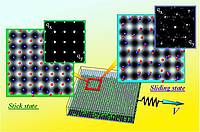
Researchers in the field of nanotribology examine micro- and nano-contacts in well-controlled geometries. Often these contacts have mobile adsorbates on the surfaces. Knowledge of physical behaviours at this scale is thought to be key to understanding how friction works on all length scales.
The aim of FANAS is to get a better insight on the origins of friction and adhesion and to learn how to control them. In particular:
- understanging relationships between adhesion and friction at the nano- and microscales and mechanisms of energy dissipation in tribological systems;
- bridging the gap between the nano, micro and macro scales in friction, lubrication and adhesion, control and modification of frictional properties;
- nanomanipulations at interfaces;
- studies of biomimetic tribological systems and tribochemistry.
Read more (FANAS leaflet, pdf 1.1Mb)
FANAS programme was launched on 17 June 2008. Click here to go to FANAS Collaborative Research Projects.
Highlights |
Professor E. Tosatti Elected to US National Academy of Sciences
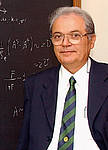
Professor E. Tosatti from ICTP in Trieste has been elected to the US National Academy of Sciences (NAS). This membership is one of the highest scientific honours in the United States; more than 180 NAS members are Nobel Prize winners. Read more...
Sliding friction and cold ion traps: bridging two worlds
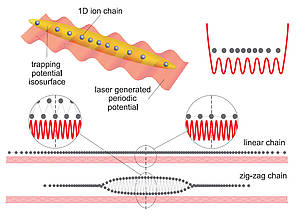
Out of serendipity, it sometimes happens in science that difficult progress in one field may unexpectedly benefit from progress in another, apparently unrelated, field.
Sliding nanofriction between material lattices on one hand and the physics of cold ion traps on the other are so far non-overlapping fields in modern nanoscience. Two sliding crystals may either stick and show static friction or slip with dynamic friction; cold ions are known to form static chains, helices or clusters, depending on the trapping conditions.
The main thrust of a fresh research article just published by prestigious Nature Communications by researchers from AFRI and ACOF CRPs is to show that this kind of serendipity might here occur and that much could be learnt about friction by sliding through an electric field the trapped ion chains over a corrugated potential.
To know more read the article published by A. Benassi, A. Vanossi, and E. Tosatti, “Nanofriction in Cold Ion Traps”, Nature Communications 2:236 doi: 10.1038/ ncomms1230 (2011).
Second Edition of the book on Contact Mechanics and Friction
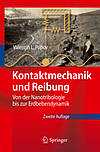
The second edition of the German version of the book Contact Mechanics and Friction, by Valentin L. Popov is available in Springer Verlag. Further information can be obtained here
Ballistic Nanofriction

Very few people in the nanofriction community have worried so far about what happens when the sliding is really high speed, a “ballistic” regime which nonetheless appears of great potential interest. Thorough a molecular dynamics simulation study, researchers from AFRI and ACOF CRPs have begun to unravel the elemental mechanisms at play in the frictional dynamics of fast sliding nano-objects deposited on crystalline surfaces. The results appear of relevance to the fundamental understanding of ballistic nanofriction as well as to potential applications in nanosystems such as, e.g., nanoelectromechanical systems and nanomotors increasingly involving large speeds of the moving interfaces. The new findings have been described by R. Guerra, U. Tartaglino, A. Vanossi, and E. Tosatti in Nature Materials 9, 634 (2010); they are highlighted by A. Schirmeisen’s paper “Nanofriction: Surfing on graphite waves” in news & views (Nature Materials 9, 615 (2010)).
Nature Materials News&Views on Nanotribology conference in Trieste
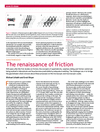
Joint ICTP-FANAS Conference Trends in Nanotribology as held in Trieste during October 19-24, 2009. It brought together both FANAS and non-FANAS scientists that are driving the experimental and theoretical developments at the forefront of atomic-scale friction research. Both theoretical/computational approaches and experimental state-of-the-art techniques were covered by the conference. Scientific achievements and challenges identified at the conference have been covered in the News&Views article by M. Urbakh and E. Meyer “The renaissance of friction” that appeared in Nature Materials in January 2010.
New book on Contact Mechanics and Friction
A new book Contact Mechanics and Friction: Physical Principles and Applications by Valentin L. Popov is in print in Springer Verlag and will be available form February 2010. Some recent results of FANAS ACOF project is presented in the chapter on active control of friction by ultrasonic oscillations.
For more information on this title visit the publisher's webpage.
More books on Tribology can be found here.
Breakthrough in atomic resolution of deposited nano-objects

EuroFANAS project NOMCIS has achieved a breakthrough in overcoming one of the main limitations in atomic resolution studies of deposited nano-objects on insulating surfaces – the identification of ions in the imaged surface. This is an important step in characterization and technology realization, since since such surfaces are critical as model substrates in molecular electronics and nanocatalysis.
Dynamical Chiral Symmetry Breaking in Sliding Nanotubes

Simulations in the group of E. Tosatti of AFRI and ACOF CRPs discovered an unanticipated nanoscale example of dynamical symmetry breaking in the sliding of perfectly left-right symmetric and nonchiral nanotubes. At a series of critical sliding velocities, corresponding to large frictional peaks, a nonzero angular momentum of phonon origin appears spontaneously.
Suppression of Friction by Mechanical Vibrations
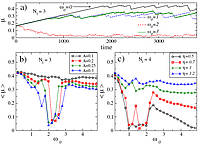
Thorough molecular dynamics simulations, researchers from AFRI and ACOF CRPs have proposed a theoretical explanation of the suppression of friction in a confined system under shear subjected to small mechanical vibrations. The important result could help in improving frictional properties of nano-devices and, as well, in explaining earthquake triggering by small dynamic perturbations.
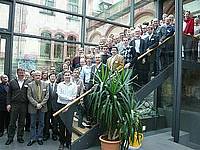
428th WE Heraeus Seminar - Physics of Tribology (11 May 2009)
From 23rd to 25 March 2009, 60 leading scientist, a large fraction of them from the FANAS collaboration, met at Physics Center in Bad Honnef to present and discuss the latest developments in Tribology were presented. The topics ranged from atomic-scale friction and molecular dynamics simulations to tribochemistry in lubricated contacts.
The conference was organized by M. Dienwiebel, M. Scherge and P. Gumbsch and was funded by the Wilhelm and Else Heraeus Foundation.
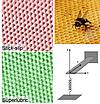
From friction reduction to superlubricity (22 March 2009)
Researchers from AFRI and ACOF CRPs have obtained dynamic superlubricity behaviour when using cantilever oscillations which are induced by a vibrating piezo-element mechanically coupled to the lever. The reduction of friction has been observed both in conductive and insulating surfaces and in vacuum and room temperature. Such results could have an impact in the extension of the lifetime of micromechanical systems (MEMS) such as computer disk drives.
To know more read the article published by E. Gnecco, A. Soculiuc, S. Maier, J. Glessler, T. Glatzel, A. Baratoff, E. Meyer, Nanotechnology, 20, 2009, 025501

Rotary motors sliding along surfaces (9 March 2009)
FANAS researchers have have studied a family of molecular rotors that may convert light or chemical energy into direct translational motion along surfaces. Simulations show that the rotation-trasnlations coupling could be very effective and the molecules might move by approximately one surface lattice spacing per complete rotation.
This research has just been published by A. E. Filippov, A. Vanossi, M. Urbakh in Phys. Rev. E, 2009, 79, 021108




